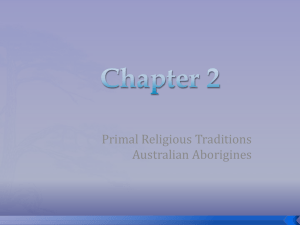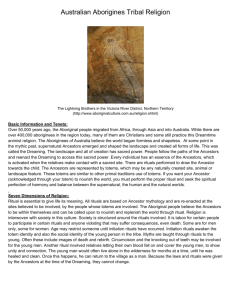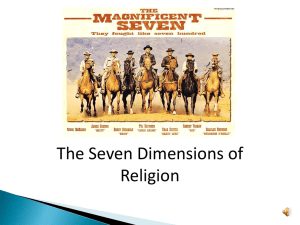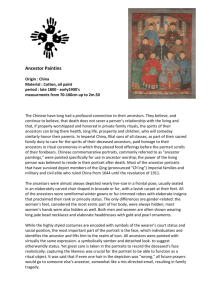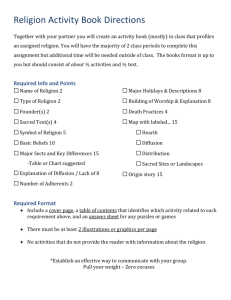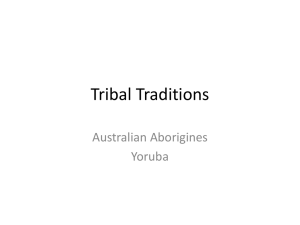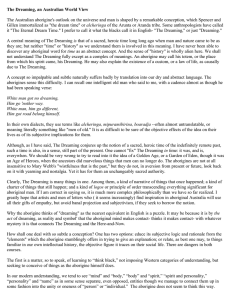Primal Religions
advertisement
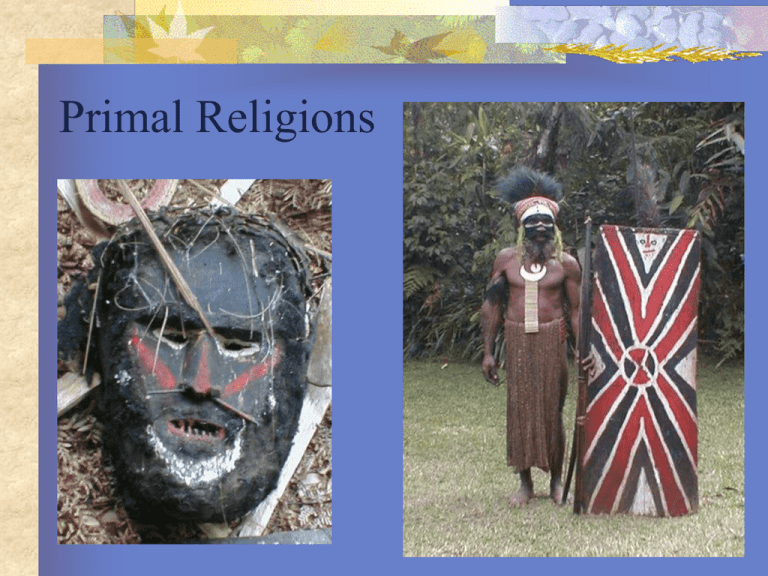
Primal Religions Primal religions originated first They are generally the traditions of nonliterate peoplewhich means they do not depend on scriptures or written teachings as do most other religions. Primal religions tend to be the traditions of tribal peoples, organized in small groups that dwell in villages as opposed to large cities - exceptions are the Yoruba of Africa and theAztecs of Mesoamerica. Four examples of Primal religions the Aborigines of Australia the Yoruba of Africa the Plain Indians of North America the Aztecs Religions of the Australian Aborigines The foundation of Aboriginal religions is the concept of the Dreaming. The world was originally formless, but at a certain point, supernatural beings called Ancestors emerged and roamed about the earth. The Ancestors gave shape to the landscape and created the various forms of life, including the first human beings. They organized humans into tribes, specified the territory each tribe was to occupy, and determined each tribe’s language, social rules and customs. The Ancestors left behind symbols of their presence. Symbols left behind The site at which these symbols are found are thought to be charged with sacred power. Only certain individuals are allowed to visit them and they must approach the symbols in a special way-following the path believed to have originally been taken by the Ancestors. The Aborigines believe in a mythic geography whereby every rock formation, a watering hole, or a cave, is believed to have great religious significance. Ayers Rock The Ayers Rock is considered very sacred for Aborigines The Ancestors and people An unborn child becomes animated by a particular Ancestor when the mother of another relative makes some form of contact with a sacred site. This animation involves a ritual that draws the Ancestor’s spiritual essence into the unborn child. Through this connection each Aborigine is a living representation of an Ancestor. This is symbolized by a totem.the natural form in which the Ancestor appeared in the Dreaming. Totems may be an animal, a rock formation or other feature of the landscape. The Aboriginal Social Structure Taboo: certain things and activities, owing to their sacred nature, are set aside for specific members of the group and are forbidden to others. Violation of this principle has been punishable by death. Restrictions are based on maturity and on an individual’s degree of religious training. Rituals Ritual is essential if life is to have meaning. Only through ritual can the sacred power of the Dreaming be accessed and experienced. Aborigines believe that the rituals themselves were taught to the first humans by the Ancestors in the Dreaming. Behind every ritual lies a myth that tells of certain actions of the Ancestors during the Dreaming. An example- the creation of the kangaroo, a chief food source, spell out exactly how and where the act of creation took place. Initiation:Symbolic death, Sacred Rebirth. These rituals awaken young people to their spiritual identity within the tribe by bringing about the” death “of childhood and the maturity needed for adulthood. The Dieri tribe of south-central Australia had an unusual initiation rite: Around a boy’s ninth birthday, the initiate’s two lower middle teeth were knocked out and buried in the ground At some time during the period of initiation, the young boy was left by himself in the wilderness for several months. When he returned, he was greeted with rejoicing and celebration and the young boy had become a man. Aboriginal Art Oldest continuing artistic tradition Native Australians began painting rock walls fifty thousand years ago; early Europeans would not decorate the caves for another 35 thousand years. Traditional Aboriginal art was immensely varied. In the north, groups made elaborate “X-ray” paintings of animal skeletons on bark and rock. In the northwest, they adorned cave walls with images of Wanjina, spiritual beings with huge eyes and no mouths. These powerful creatures, it was believed, observed all things but passed no judgments. The Dreaming Ground paintings, a communal effort, were fashioned directly on the sand. They were made during secret rites that celebrated the “creation ancestors” - supernatural beings who were thought to have formed every detail of the landscape, from sandhill ro riverbank. Each Aborigine inherited responsibility for a particular Dreaming story and the parcel of land on which it took place. This type of painting involved thousands of dots and after the ceremony was over, the painting was destroyed.

